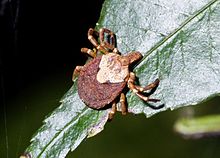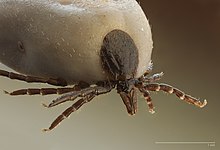|
Ixodidae
The Ixodidae are the family of hard ticks or scale ticks,[1] one of the three families of ticks, consisting of over 700 species. They are known as 'hard ticks' because they have a scutum or hard shield, which the other major family of ticks, the 'soft ticks' (Argasidae), lack. They are ectoparasites of a wide range of host species, and some are vectors of pathogens that can cause human disease.[citation needed] DescriptionThey are distinguished from the Argasidae by the presence of a scutum.[2] In both the nymph and the adult, a prominent gnathosoma (or capitulum, mouth and feeding parts) projects forward from the animal's body; in the Argasidae, conversely, the gnathosoma is concealed beneath the body.[citation needed] They differ, too, in their lifecycle; Ixodidae that attach to a host bite painlessly and are generally unnoticed, and they remain in place until they engorge and are ready to change their skin; this process may take days or weeks. Some species drop off the host to moult in a safe place, whereas others remain on the same host and only drop off once they are ready to lay their eggs.[citation needed] Classification There are 702 species in 14 genera.[3] The family contains these genera:[3]
Fossil genera
Medical importanceMany hard ticks are of considerable medical importance, acting as vectors of diseases caused by bacteria, protozoa, and viruses, such as Rickettsia and Borrelia.[2] Other tick-borne diseases include Lyme disease, babesiosis, ehrlichiosis, Rocky Mountain spotted fever, anaplasmosis, Southern tick-associated rash illness, tick-borne relapsing fever, tularemia, Colorado tick fever, Powassan encephalitis, and Q fever.[4] See alsoReferences
External links |
||||||||||||||||||||||||

